Select Chapter Topics:
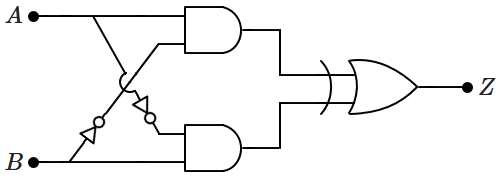
Which is the correct truth table for a given circuit?
1.
\(A\)
\(B\)
\(Z\)
2.
\(A\)
\(B\)
\(Z\)
\(0\)
\(0\)
\(1\)
\(0\)
\(0\)
\(0\)
\(0\)
\(1\)
\(1\)
\(0\)
\(1\)
\(1\)
\(1\)
\(0\)
\(1\)
\(1\)
\(0\)
\(1\)
\(1\)
\(1\)
\(0\)
\(1\)
\(1\)
\(0\)
3.
\(A\)
\(B\)
\(Z\)
4.
\(A\)
\(B\)
\(Z\)
\(0\)
\(0\)
\(0\)
\(0\)
\(0\)
\(0\)
\(0\)
\(1\)
\(0\)
\(0\)
\(1\)
\(1\)
\(1\)
\(0\)
\(0\)
\(1\)
\(0\)
\(0\)
\(1\)
\(1\)
\(1\)
\(1\)
\(1\)
\(1\)
Subtopic: Logic gates |
From NCERT
JEE
Please attempt this question first.
Hints
Please attempt this question first.
The truth table for the combination of logical gates
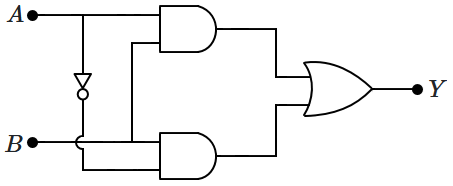

| 1. | \(A\) | \(B\) | \(C\) | 2. | \(A\) | \(B\) | \(C\) | |
| \(0\) | \(0\) | \(0\) | \(0\) | \(0\) | \(0\) | |||
| \(0\) | \(1\) | \(0\) | \(0\) | \(1\) | \(0\) | |||
| \(1\) | \(0\) | \(0\) | \(1\) | \(0\) | \(1\) | |||
| \(1\) | \(1\) | \(1\) | \(1\) | \(1\) | \(1\) | |||
| 3. | \(A\) | \(B\) | \(C\) | 4. | \(A\) | \(B\) | \(C\) | |
| \(0\) | \(0\) | \(0\) | \(0\) | \(0\) | \(0\) | |||
| \(0\) | \(1\) | \(1\) | \(0\) | \(1\) | \(1\) | |||
| \(1\) | \(0\) | \(0\) | \(1\) | \(0\) | \(0\) | |||
| \(1\) | \(1\) | \(1\) | \(1\) | \(1\) | \(0\) | |||
Subtopic: Logic gates |
From NCERT
JEE
Please attempt this question first.
Hints
Please attempt this question first.
In the voltage regulator circuit shown below, the reverse breakdown voltage of the Zener diode is \(3~\text{V}.\)Then the current through the Zener diode is:
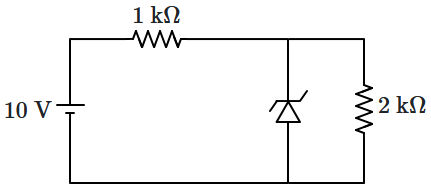
1. \(7~\text{mA}\)
2. \(1.5~\text{mA}\)
3. \(5.5~\text{mA}\)
4. \(10~\text{mA}\)

1. \(7~\text{mA}\)
2. \(1.5~\text{mA}\)
3. \(5.5~\text{mA}\)
4. \(10~\text{mA}\)
Subtopic: PN junction |
From NCERT
JEE
Please attempt this question first.
Hints
Please attempt this question first.
What is the current through the zener diode if its breakdown voltage is \(5~\text V?\)

1. \(58.33 ~\text{mA}\)
2. \(25 ~\text{mA}\)
3. \(28.33 ~\text{mA}\)
4. \(20.33 ~\text{mA}\)

1. \(58.33 ~\text{mA}\)
2. \(25 ~\text{mA}\)
3. \(28.33 ~\text{mA}\)
4. \(20.33 ~\text{mA}\)
Subtopic: Types of Semiconductors |
From NCERT
JEE
Please attempt this question first.
Hints
Please attempt this question first.
In which of the following circuits the diode is reverse-biased?
| (i) |  |
| (ii) |  |
| (iii) | 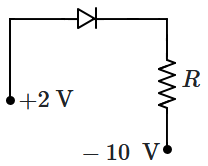 |
| (iv) | 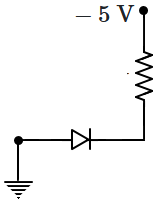 |
| 1. | (ii) | 2. | (i) and (iv) |
| 3. | (iv) | 4. | (i) |
Subtopic: PN junction |
71%
From NCERT
JEE
Please attempt this question first.
Hints
Please attempt this question first.
A \(2~\text V\) battery is connected across \({AB}\) as shown in the figure. The value of the current supplied by the battery when in one case battery's positive terminal is connected to \(A\) and in another case when the positive terminal of the battery is connected to \({B}\) will respectively be:

1. \(0.4~\text{A}\) and \(0.2~\text{A}\)
2. \(0.2~\text{A}\) and \(0.4~\text{A}\)
3. \(0.1~\text{A}\) and \(0.2~\text{A}\)
4. \(0.2~\text{A}\) and \(0.1~\text{A}\)

1. \(0.4~\text{A}\) and \(0.2~\text{A}\)
2. \(0.2~\text{A}\) and \(0.4~\text{A}\)
3. \(0.1~\text{A}\) and \(0.2~\text{A}\)
4. \(0.2~\text{A}\) and \(0.1~\text{A}\)
Subtopic: Applications of PN junction |
80%
From NCERT
JEE
Please attempt this question first.
Hints
The value of the resistor \({R_s},\) needed in the DC voltage regulator circuit shown here, equals:

1. \({\frac{\left(V_i-V_L\right)}{(n+1) I_L}}\)
2. \({\frac{\left(V_i+V_L\right)}{(n+1) I_L}}\)
3. \({\frac{\left(V_i-V_L\right)}{n I_L}}\)
4. \({\frac{\left(V_i+V_L\right)}{n I_L}}\)

1. \({\frac{\left(V_i-V_L\right)}{(n+1) I_L}}\)
2. \({\frac{\left(V_i+V_L\right)}{(n+1) I_L}}\)
3. \({\frac{\left(V_i-V_L\right)}{n I_L}}\)
4. \({\frac{\left(V_i+V_L\right)}{n I_L}}\)
Subtopic: Applications of PN junction |
79%
From NCERT
JEE
Please attempt this question first.
Hints
Please attempt this question first.
In an unbiased p-n junction electrons diffuse from the n-region to the p-region because:
| 1. | electrons travel across the junction due to potential difference |
| 2. | electron concentration in the n-region is more as compared to that in the p-region |
| 3. | only electrons move from the n to p region and not the vice-versa. |
| 4. | holes in the p-region attract them |
Subtopic: PN junction |
69%
From NCERT
JEE
Please attempt this question first.
Hints
Please attempt this question first.
The \(V\text-I\) characteristic of a diode is shown in the figure. The ratio of forward to reverse bias resistance is:

1. \(10\)
2. \(10^{-6}\)
3. \(100\)
4. \(10^6\)

1. \(10\)
2. \(10^{-6}\)
3. \(100\)
4. \(10^6\)
Subtopic: PN junction |
64%
From NCERT
JEE
Please attempt this question first.
Hints
What is the conductivity of a semiconductor sample having electron concentration of \(5\times10^{18}~\text{m}^{-3},\) hole concentration of \(5\times10^{19}~\text{m}^{-3},\) electron mobility of \(2.0~\text{m}^2~\text{V}^{-1}\text{s}^{-1}\) and hole mobility of \(0.01~\text{m}^2\text{V}^{-1}~\text{s}^{-1}?\)
(Take charge of an electron as \(1.6\times10^{-19}~\text{C})\)
1. \(0.59~(\Omega\text-\text{m})^{-1}\)
2. \(1.20~(\Omega\text-\text{m})^{-1}\)
3. \(1.68~(\Omega\text-\text{m})^{-1}\)
4. \(1.83~(\Omega\text-\text{m})^{-1}\)
(Take charge of an electron as \(1.6\times10^{-19}~\text{C})\)
1. \(0.59~(\Omega\text-\text{m})^{-1}\)
2. \(1.20~(\Omega\text-\text{m})^{-1}\)
3. \(1.68~(\Omega\text-\text{m})^{-1}\)
4. \(1.83~(\Omega\text-\text{m})^{-1}\)
Subtopic: Energy Band theory |
63%
From NCERT
JEE
Please attempt this question first.
Hints




